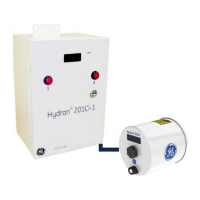• One of the fault triggers conditions, listed in Table 11-1 (for details, see Section
11.5.2 below).
11.5.2 Fault Triggers
Fault triggers are fail alarm conditions that can produce two actions:
1. Display of a message on the screen. The alarm message is displayed only if the
corresponding alarm set point is adjusted to a value; if not, it is set to OFF. This
setting is performed in the corresponding submenu.
2. Trigger of the fail alarm relay. Whether the relay is triggered when an alarm
condition is detected is determined in the SysOK Relay; FaultTrig. submenu.
Note: The alarm set point adjustment has priority over the relay triggering. In other
words, the relay is not triggered if the alarm set point is adjusted to OFF.
Almost all these alarm conditions have an alarm set point and an alarm delay (both
can be adjusted). The fail alarm, for these conditions, is therefore triggered the same
way than the gas High and High-High alarms:
• Low and Low-Low alarms: The fail alarm is triggered when one of the alarm
conditions is below the corresponding alarm set point during a period of time
exceeding its alarm delay.
• High and High-High alarms: The fail alarm is triggered when one of the alarm
conditions exceeds the corresponding alarm set point during a period of time
exceeding its alarm delay.
1.1.1.8 Gas Fault Triggers
The conditions shown in Table 11-7 although being Low and Low-Low gas alarms,
are classified as fail alarms because they indicate a problem of gas detection rather than
one of gas production in the transformer. A gas Low alarm, for example, is triggered if
the valve on which is mounted the Hydran 201Ti is closed.
The parameters pertaining to these alarm conditions are set in the H201Ti’s Gas and
SysOK Relay; FaultTrig. submenus (for explanations, see Chapter 5).

